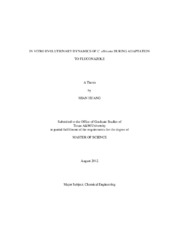| dc.description.abstract | Many drug-resistant mechanisms in Candida albicans (C. albicans), a clinical important fungal pathogen, have been well characterized. However, few studies investigated the emergence of drug resistance from the evolutionary perspective and little is known about the evolutionary trajectories during the adaptation to the drug. Here, we examined the evolutionary dynamics of C. albicans both in the presence and absence of fluconazole, a first line drug, using the visualizing evolution in real-time (VERT) method.
Evolutionary dynamics of replicate C. albicans populations, either in the presence or absence of fluconazole, were determined and adaptive mutants arose in the populations were systematically isolated using the VERT method. Drug susceptibility assays were performed to measure the fluconazole minimum inhibitory concentration (MIC) for the adaptive isolates from drug-exposed populations. Analysis of the evolutionary dynamics revealed that mutations arose more frequently in the presence of the drug compared to the absence of the drug and the drug-resistant mutations occurred in independent lineages, suggesting a heterogeneous nature of the populations during the adaptation. In addition, fitness effects were evaluated for each adaptive mutant both in the presence and absence of drug and we found most of them gained significant increase in the drug resistance without a fitness cost in the absence of the drug. Interestingly, the aneuploidy and gross chromosomal rearrangements, common drug-resistant mechanisms, were not responsible for the increased resistance to fluconazole of most adaptive isolates, suggesting single-nucleotide polymorphisms (SNPs) or other stable unknown chromosomal rearrangements may contribute to the increased drug resistance. | en |


